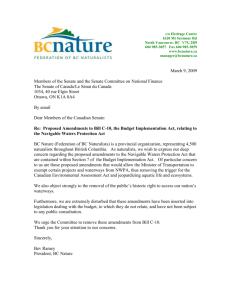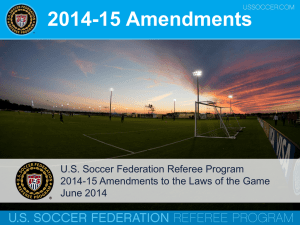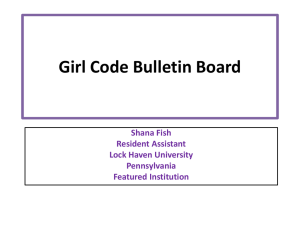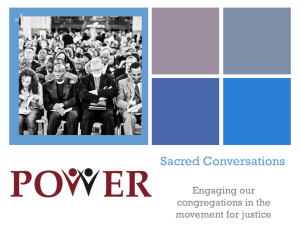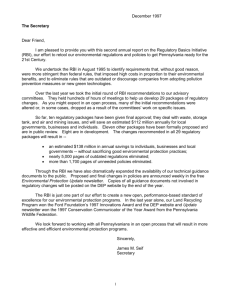Final Report
advertisement
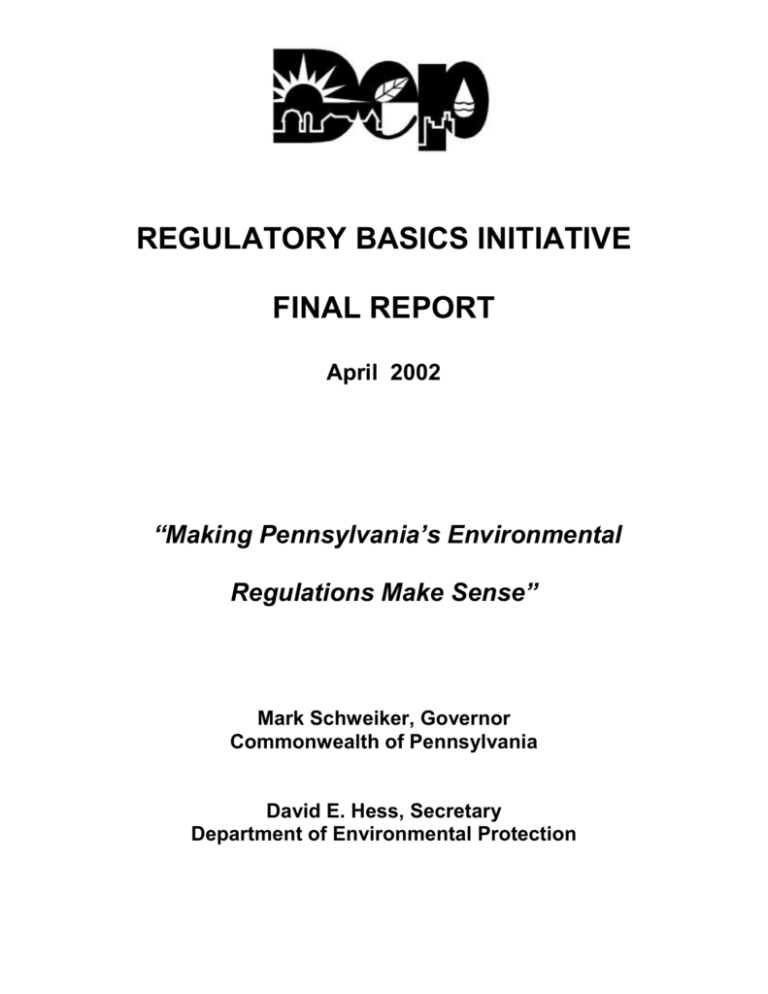
REGULATORY BASICS INITIATIVE FINAL REPORT April 2002 “Making Pennsylvania’s Environmental Regulations Make Sense” Mark Schweiker, Governor Commonwealth of Pennsylvania David E. Hess, Secretary Department of Environmental Protection TABLE OF CONTENTS Page INTRODUCTION ............................................................................................................. 1 REVIEW OF REGULATIONS ......................................................................................... 2 I. Program Reports Evaluating the Regulations ....................................................... 2 II. Summary of RBI Regulatory Changes .................................................................. 3 Land Recycling and Waste Management ................................................................. 3 Hazardous and Municipal Waste Amendments ............................................. 3 Municipal and Residual Waste/Sewage Sludge ............................................ 3 Universal Waste Rule .................................................................................... 3 Chapters 271-285, Municipal Waste Amendments ....................................... 4 Chapters 287-299, Residual Waste Amendments ......................................... 4 Air Quality ................................................................................................................ 5 Air Quality Amendments - RBI #1 .................................................................. 5 Air Quality Amendments - RBI #2 .................................................................. 5 Surface Coating Processes – RBI #4 ............................................................ 5 Water Management.................................................................................................. 6 Storage Tanks - Technical Standards ........................................................... 6 Municipal Financial Assistance...................................................................... 6 Chapter 94 - Municipal Wasteload Management........................................... 6 Chapter 102, Erosion Control ........................................................................ 6 Chapters 92, 93, 95, 96 and 97 ..................................................................... 7 i Mineral Resources ................................................................................................... 7 General Bonding, Civil Penalties and Areas Unsuitable for Mining ............... 7 Small Operator Assistance Program (SOAP) ................................................ 7 Noncoal Mining.............................................................................................. 8 Oil and Gas Well Amendments ..................................................................... 8 Coal Mine Permitting and Performance Standards ....................................... 8 Mine Subsidence Control, Subsidence Damage Repair and Water Supply Replacement (Act 54) ............................................................. 8 General Provisions and Areas Unsuitable for Mining .................................... 9 PENDING PROPOSALS ................................................................................................. 9 New Source Review ...................................................................................... 9 Chapter 105 - Dam Safety and Waterway Management ............................... 9 PROPOSALS WITHDRAWN ........................................................................................ 10 Malodors - RBI #3 ....................................................................................... 10 Repeal of Chapter 171 (Schools) ................................................................ 10 REVIEW OF TECHNICAL GUIDANCE ......................................................................... 10 I. Program Reports Evaluating Technical Guidance .............................................. 10 II. Increasing Public Access/eNotice....................................................................... 11 ESTIMATED COST SAVINGS TO THE COMMONWEALTH ....................................... 12 ESTIMATED COST SAVINGS TO INDIVIDUALS, LOCAL GOVERNMENTS, AND THE REGULATED COMMUNITY......................................................................... 12 NEED MORE INFORMATION? .................................................................................... 14 ii REGULATORY BASICS INITIATIVE “Making Pennsylvania’s Environmental Regulations Make Sense” INTRODUCTION The Regulatory Basics Initiative (RBI) was an unprecedented effort on the part of the Department of Environmental Protection (DEP) to ensure that Pennsylvania’s environmental regulations make sense and are working in the most effective way possible. The purpose of the RBI was to assure that DEP requirements are no more stringent than standards imposed by Federal law without good reason; to minimize cost on the regulated community; to eliminate requirements that are no longer necessary or redundant; to encourage performance or outcome-based requirements; to facilitate the use of new green technologies; to eliminate barriers to recycling and pollution prevention; and to assure information is prepared in clear and concise language. The success of the initiative is attributable to the combined efforts of DEP staff and many private citizens, local governments and businesses. Since August of 1995, when the RBI was launched, DEP accomplished the following: Reviewed 5,000 pages of regulations and 16,000 pages of policies to identify areas in need of revision. Proposed 25 regulatory packages, beginning with the Universal Waste Rule. Conducted over 35 public hearings, received and responded to over 1,040 public comment letters, and worked with DEP’s 27 advisory committees made up of Pennsylvania citizens to obtain public input. Deleted 4,500 pages of outdated, confusing or unnecessary guidance documents. Made all 11,500 remaining pages of technical guidance documents available instantaneously to the public through the DEP website (www.dep.state.pa.us). Drafted regulatory changes to reduce the time spent on redundant administrative activities to save approximately $5 million in DEP staff time since RBI began. Drafted revisions to save the regulated community and local governments an estimated $672 million in compliance costs since the program’s inception. A 90-day public comment period on the RBI took place from August 19, 1995 until November 15, 1995. Comments were received from 113 commentators (59 businesses and trade associations, 32 citizens, 12 consultants, 7 environmental organizations, and 3 municipalities and municipal authorities). These individuals and groups provided a total of 962 comments and recommendations. 1 These comments contributed to many of the proposed amendments that led to regulatory improvements. The recommendations were grouped by subject matter and resulted in the development of 25 separate regulatory packages. Each regulatory proposal was reviewed by one or more of DEP’s 27 advisory committees before it was forwarded to the Environmental Quality Board (EQB). REVIEW OF REGULATIONS I. Program Reports Evaluating the Regulations Beginning in August 1995, DEP reviewed all of its existing regulations. As a result of this review, an estimated 152 of 4,987 Pennsylvania Code pages of regulations were identified for deletion, which included approximately 1,716 of the existing 55,000 regulatory requirements. The intent of these deletions and revisions was to encourage performance-based requirements, minimize costs, clarify requirements and eliminate barriers to recycling and pollution prevention. The review consisted of a section-bysection analysis of DEP’s regulations using the criteria detailed below, as well as a review of the public comments submitted during the public comment period. DEP program staff developed reports evaluating the regulations and recommended regulatory changes. When evaluating the requirements for possible revisions or deletions, the programs sought to identify: Regulations that contained standards or requirements more stringent than federal law, without good reason. Regulations that imposed disproportionate economic costs without significant benefit. Regulations with significant noncompliance. Regulations that were prescriptive or technology specific. Regulations that inhibited the application of new green technologies. Regulations that did not support a pollution prevention approach. Regulations that were obsolete or redundant. Regulations that lacked clarity. The Department identified regulations where the text created the potential for misinterpretation due to not being drafted in plain, simple, clear and concise language. 2 II. Summary of RBI Regulatory Changes This listing summarizes the regulatory changes that constitute the RBI. A brief description of each regulatory package follows: Land Recycling and Waste Management Hazardous and Municipal Waste Amendments The amendments updated the Department’s existing regulations by correcting technical errors, clarifying ambiguous sections, addressing concerns raised by affected industry representatives through the PK-4 industrial working group, and conforming to recent EPA regulation changes. EQB Adoption Date: October 15, 1996 Pennsylvania Bulletin Publication Date: January 11, 1997 Municipal and Residual Waste/Sewage Sludge This proposal amended the municipal waste regulations by adding Subchapters I and J to Chapter 271, providing for the issuance of general permits for the beneficial use or processing of municipal waste/sewage sludge. The proposal also amended the residual waste regulations to provide consistency in the implementation of general permits between the two programs. EQB Adoption Date: October 15, 1996 Pennsylvania Bulletin Publication Date: January 25, 1997 Universal Waste Rule These amendments streamlined requirements for the collection and management of universal wastes, such as nickel-cadmium and other types of batteries, certain hazardous waste pesticides, and mercurycontaining thermostats, and provided for the environmentally responsible management and recycling of these wastes without over-regulating the materials. The rulemaking also included a petition process to place additional wastes under similar controls. EQB Adoption Date: March 18, 1997 Pennsylvania Bulletin Publication Date: June 14, 1997 Municipal, Residual and Infectious and Chemotherapeutic Waste Reporting Requirements/County Municipal Waste Plan Revisions These amendments to the municipal and residual waste regulations eliminated duplicative data submission and reduced unnecessary or redundant recordkeeping requirements for the regulated community while assuring continued environmental protection as well as public access to information. The amendments also implemented a recommendation from the Municipal Waste Stakeholders Group to amend § 272.252(e) to allow 3 counties to add or delete a waste management facility to or from their county municipal waste management plan through a nonsubstantial plan revision, allowing counties to act more quickly to adjust their plans to take advantage of market conditions. EQB Adoption Date: September 16, 1997 Pennsylvania Bulletin Publication Date: November 29, 1997 Chapters 260-270, Comprehensive Hazardous Waste Amendments These amendments incorporated many of the federal RCRA regulations by reference. Major changes to Pennsylvania’s regulations included adopting the federal definition of waste and adding federal land disposal restrictions and boiler and industrial furnace requirements (the “BIF” rule). These amendments included numerous changes to make Pennsylvania requirements consistent with the federal standards, as well as replacing specific design standards with performance-based standards where possible. EQB Adoption Date: February 16, 1999 Pennsylvania Bulletin Publication Date: May 1, 1999 Chapters 271-285, Municipal Waste Amendments Pennsylvania was granted federal approval for its municipal waste program in 1994, based on its municipal waste regulations. These amendments addressed the applicability of the new land recycling cleanup standards at permitted municipal waste sites, standards for the proper storage of waste tires, improvements to the equivalency review procedures, expansion of the types of activities that are eligible for general permits, changes to the environmental assessment procedure as a result of the Governor’s Executive Order on municipal waste facilities, and new requirements for the control of nuisances such as odors. EQB Adoption Date: September 19, 2000 Pennsylvania Bulletin Publication Date: December 23, 2000 Chapters 287-299, Residual Waste Amendments There is no federal regulatory equivalent to Pennsylvania’s residual waste regulations; however, several revisions were proposed as a result of the RBI. Significant changes included the applicability of the new land recycling cleanup standards at permitted residual waste sites, expansion of the types of activities that are eligible for general permits, and revisions to the definitions of “waste” and “clean fill.” EQB Adoption Date: September 19, 2000 Pennsylvania Bulletin Publication Date: January 13, 2001 4 Air Quality Air Quality Amendments - RBI #1 The amendments conformed the Chapter 121 definitions for “coke ovens,” “major modification,” “modification,” “potential to emit,” “responsible official” and “secondary emissions” to the federal definitions of these terms. The changes to Chapter 122 incorporated by reference the New Source Performance Standard (NSPS) guidelines established under § 111(d) of the Clean Air Act. The changes to Chapter 123 make this regulation consistent with the Maximum Achievable Control Technology (MACT) standards for coke ovens promulgated by the Environmental Protection Agency (EPA) through the Clean Air Act. A Chapter 137 amendment eliminated the mandatory requirement for submission of standby plans to address air pollution episodes. The changes to Chapter 139 established consistent data availability requirements for all continuous emission monitoring (CEM) sources and extended the monitoring provisions applicable to municipal waste incinerators to hospital waste incinerators. EQB Adoption Date: September 16, 1997 Pennsylvania Bulletin Publication Date: December 27, 1997 Air Quality Amendments - RBI #2 The amendments deleted portions of Chapter 128 that established alternative emission reduction limitations for certain air contamination sources; allowed 45 days in § 129.56 for repairs of defective seals on floating roof storage tanks of 40,000 gallons or more (with up to a 30-day extension); revised § 129.67(b)(2) to insert the term “less water,” which was inadvertently deleted in a previous rulemaking; deleted the perchloroethylene (perc) requirements for dry cleaning facilities in § 129.70 since EPA no longer considers perc a VOC; and deleted the Pennsylvania ambient air quality standards for certain constituents in Chapters 131 and 139 because they are not required under the Clean Air Act. EQB Adoption Date: June 16, 1998 Pennsylvania Bulletin Publication Date: September 5, 1998 Surface Coating Processes – RBI #4 These amendments simplified the calculation procedure for determining compliance with the regulatory provisions and considered small source exemptions to the extent possible without degrading air quality. EQB Adoption Date: March 31, 2000 Pennsylvania Bulletin Publication Date: June 10, 2000 5 Water Management Storage Tanks - Technical Standards Amendments included minor revisions to definitions in Chapter 245, Subchapter A; relocating language adopting the federal underground storage tank regulations to new Subchapter E; and adopting by reference the federal regulations relating to lender liability. The rulemaking also established a permitting program for storage tanks as well as separate technical and operational standards for aboveground storage tanks. The package was the last major new rulemaking for implementation of Pennsylvania’s storage tank program as authorized by the Storage Tank and Spill Prevention Act. EQB Adoption Date: July 15, 1997 Pennsylvania Bulletin Publication Date: October 11, 1997 Municipal Financial Assistance Amendments included changes to Subchapters A and D of Chapter 103. The grant program portion of Subchapter A was no longer needed as a result of the Title VI State Water Pollution Control Revolving Fund replacing Title II provisions of the Clean Water Act. Subchapter D amendments deleted provisions related to a state design grant program and supplemental construction grant program that were no longer needed since all eligible communities have been awarded grants and were paid. New text was added to allow the Department to award grants for construction of municipal sewage facilities to one or more economically depressed communities. Approximately $155,000 was made available from the Land and Water Conservation and Reclamation Act bond proceeds for this effort. EQB Adoption Date: October 21, 1997 Pennsylvania Bulletin Publication Date: January 3, 1998 Chapter 94 - Municipal Wasteload Management These amendments deleted regulations related to the implementation of the federal pretreatment program. The regulations were unnecessary because DEP did not accept delegation of this EPA program. The rulemaking also clarified annual reporting requirements for municipal facility permittees. EQB Adoption Date: June 16, 1998 Pennsylvania Bulletin Publication Date: September 5, 1998 Chapter 102, Erosion Control These amendments provided flexibility in implementing Best Management Practices (BMPs) for a wide range of earth disturbance activities, integrated the federal requirements for NPDES Stormwater Construction permits, clarified the planning and permitting requirements, and 6 streamlined the regulatory process for projects with minimal risk or threats to the environment. EQB Adoption Date: September 21, 1999 Pennsylvania Bulletin Publication Date: January 1, 2000 Chapters 91, 97 and 101 - Wastewater Management The amendments consolidated existing provisions of parts of Chapters 97 and 101 into a single source -- Chapter 91. The consolidation provided easy reference to related water pollution control requirements. The rulemaking also provided the regulated community and DEP greater flexibility in implementing pollution prevention measures and improved the permitting program by providing authority for DEP to issue general water quality management permits. EQB Adoption Date: September 21, 1999 Pennsylvania Bulletin Publication Date: January 29, 2000 Chapters 92, 93, 95, 96 and 97 The purpose of these revisions was twofold -- to address changes needed to address RBI priorities and incorporate changes needed to implement the federal Great Lakes Water Quality Initiative (GLI). EQB Adoption Date: June 20, 2000 Pennsylvania Bulletin Publication Date: November 18, 2000 Mineral Resources General Bonding, Civil Penalties and Areas Unsuitable for Mining Chapter 86 was amended to address requirements that were more stringent than Federal law and included revised definitions for “related party” and “owned or controlled and owns or controls,” and a new definition for “willful violation.” The amendments also revised the designation of areas unsuitable for mining process as well as bonding requirements and civil penalties. EQB Adoption Date: September 16, 1997 Pennsylvania Bulletin Publication Date: November 29, 1997 Small Operator Assistance Program (SOAP) The amendments deleted redundant language, conformed to existing Federal requirements, and otherwise clarified the regulations, which are applicable to coal mine operators producing less than 300,000 tons of coal per year and wish to obtain program assistance. EQB Adoption Date: October 21, 1997 Pennsylvania Bulletin Publication Date: January 3, 1998 7 Noncoal Mining These amendments created a definition for general permits and a new subchapter to develop general permits for certain categories of noncoal mining; clarified bonding and insurance requirements; and simplified and clarified information, operation and reclamation requirements as well as environmental performance standards. EQB Adoption Date: October 21, 1997 Pennsylvania Bulletin Publication Date: January 31, 1998 Oil and Gas Well Amendments Chapter 78 amendments simplified notification and reporting requirements and clarified requirements for the discharge of tophole water to the land surface, surface casing and cementing procedures, and plugging procedures for wells in coal areas. A single change to Chapter 79 was for conformance with Chapter 78 requirements. Chapter 80 was deleted in its entirety because the Federal Gas Well Classification program was terminated. EQB Adoption Date: December 16, 1997 Pennsylvania Bulletin Publication Date: March 7, 1998 Coal Mine Permitting and Performance Standards These amendments addressed provisions that are more stringent than Federal regulations relating to standards governing protection of the hydrologic balance, protection of fish and wildlife, and prevention of erosion with reference to permitting requirements and performance standards for surface coal mining. EQB Adoption Date: June 20, 1998 Pennsylvania Bulletin Publication Date: May 9, 1998 Mine Subsidence Control, Subsidence Damage Repair and Water Supply Replacement (Act 54) Chapter 89 was amended to incorporate new requirements and delete requirements no longer applicable as a result of Act 54 of 1994 amendments to the Bituminous Mine Subsidence and Land Conservation Act (BMSLCA). Subchapter F was restructured to separate into three sections those requirements that apply to subsidence damage, those that apply to water supply damage, and those that apply generally to underground mining activities. The amendments also recognized the different regulatory requirements necessary for longwall mining operations versus underground mining methods; set forth the requirements for premining and postmining structural surveys; and changed mapping 8 requirements to require operators to identify water supplies as well as structures that may be impacted by underground mining activities. EQB Adoption Date: March 17, 1998 Pennsylvania Bulletin Publication Date: June 13, 1998 General Provisions and Areas Unsuitable for Mining These amendments addressed regulations that are more stringent than federal requirements, improved clarity, and amended various sections concerning definitions and procedures relating to the Areas Unsuitable for Mining (AUFM) program. The amendments enabled DEP, and not the EQB, to conduct the public hearings associated with UFM designation requests and gave DEP 12 months within which to make a decision on the request in the form of a recommendation to the EQB. EQB Adoption Date: July 20, 1999 Pennsylvania Bulletin Publication Date: October 9, 1999 PENDING PROPOSALS New Source Review Pennsylvania’s new source review and emission reduction credit regulations (NSR program) will be revised after the EPA amends the Federal NSR program. In 1996 and 1998 EPA published proposed changes to reform NSR, but none have been finalized. EPA will likely finalize certain aspects of the 1996 and 1998 proposals including plantwide applicability limit, pollution control project exclusion and “clean unit” requirements as final-form regulations in 2002. In addition, President Bush has proposed the “Clear Skies” Initiative, a threepollutant cap-and-trade program to control sulfur dioxide, nitrogen oxide and mercury emissions from large power plants. Federal legislation may be enacted to establish the emission caps. EPA is expected to propose additional revisions to the federal NSR requirements this year. The Environmental Quality Board will consider revisions to Pennsylvania’s NSR program after EPA has finalized the national NSR requirements. Chapter 105 - Dam Safety and Waterway Management Revisions will be proposed to simplify and clarify the regulations, streamline the process for minor wetland encroachments, establish discretion to issue expedited permit decisions during site visits, simplify the application fee schedule, and clarify the Chapters 105 and 106 programs by consolidating rules and procedures for stream channels, floodways and floodplains into one regulation. DEP continues to work with its Wetlands Protection Advisory Committee to discuss these issues. 9 PROPOSALS WITHDRAWN Malodors - RBI #3 Amendments were proposed to clarify the definition of “malodor,” add a definition for “odor investigation,” allow a single member of the public to initially identify the objectionable odor and allow the DEP air program staff to investigate and determine whether an objectionable odor exists, and provide that a facility that controls malodorous air contaminants through the use of Best Available Technology (BAT) will not be required to further reduce residual odors for a five-year period. The proposal was withdrawn from further consideration on September 21, 1999, as a result of approximately 40 comments from 93 individuals who opposed the changes. Withdrawn: September 21, 1999 Repeal of Chapter 171 (Schools) This proposal would have repealed Chapter 171, which establishes standards for design and operation of schools pertaining to water supply, plumbing, sewage disposal, and more. Over the past ten years, other agencies such as the Departments of Education, Agriculture, Health, and Labor and Industry participated in the oversight of various environmental health-related aspects of school sanitation. Due to ongoing discussions with these agencies on sharing these responsibilities, the proposal was not finalized. As a result, it was deemed withdrawn on March 10, 1999, two years following the close of the public comment period on the proposed rulemaking. DEP will continue to exercise authority over important sanitary aspects of school facilities through the drinking water, sewage facilities and waste management regulatory programs. Deemed Withdrawn: March 10, 1999 REVIEW OF TECHNICAL GUIDANCE I. Program Reports Evaluating Technical Guidance Technical Guidance documents are the official policies of the Department, many of which detail the Department’s prescribed methods for complying with its regulations. As part of the RBI, the Department reviewed over 16,000 pages of technical guidance documents to meet the goals of the initiative. The guidance documents were then revised or eliminated in accordance with the following criteria: Conformity with State Statutes and Regulations No More Stringent than Federal Requirements Positive Economic Impacts Compliance Assistance 10 Performance or Outcome Oriented Do Not Inhibit the Use of Green Technologies Support Pollution Prevention Approach Are Necessary and Not Redundant Clarity The program reports evaluating the Department’s technical guidance documents were released in August 1996 and mailed to the individuals who submitted comments during the public comment period. These reports were also provided to the Department’s advisory committees for review and comment. Of the 16,000 pages of technical guidance that existed in 1996, 4,500 pages were deleted. II. Increasing Public Access/eNotice DEP has led the way among state environmental protection agencies in making the tools and documents it uses available and accessible to the public. The Department developed an inventory of all the technical guidance it uses. This complete technical guidance document inventory is available on the web site. This general movement towards providing information electronically has improved the speed and efficiency with which the Department can provide information to the public and has reduced waste and expense. The number of technical guidance documents mailed to the public since 1997 has been reduced substantially and continues to decline each year. The eNotice system was started in January 2002, to increase public participation and involvement on the status of new policies and technical guidance documents. ENotice provides citizens with customized information directly in their “mailbox” or email account – thereby eliminating the need for an individual to search for the information at various offices. The new eNotice was established to take advantage of such rapid technology transfer for citizen use. Instead of using traditional public advertising methods, the new eNotice system directly notifies by email and provides access to a web-based system of notices and respective documents. 11 ESTIMATED COST SAVINGS TO THE COMMONWEALTH One of the goals of the RBI was to improve the efficiency by which the Department approves permit applications, conducts its monitoring, and reviews reporting documentation. The intent was that the Department spend less time on administrative activities and more time on the qualitative endeavors that directly affect the quality of Pennsylvania’s environment. The changes implemented through the RBI are resulting in estimated annual savings of $1,025,319 worth of staff time to the Commonwealth. One of the changes that contributed to these savings is a move toward general permits where practicable. These permits require less time for the regulated community to complete and for the Department to review, without sacrificing the level of analysis and environmental protection. Savings have also resulted from the drafting of strict technical guidance documents for permit reviews. These documents eliminate ambiguities and help to improve consistency of review. This not only saves taxpayer dollars, but improves the quality of the work the Department performs. ESTIMATED COST SAVINGS TO INDIVIDUALS, LOCAL GOVERNMENTS, AND THE REGULATED COMMUNITY While the RBI saved taxpayer dollars and increased environmental protection in various innovative ways, another equally compelling focus of the initiative was to alter Pennsylvania’s environmental regulations so that they make sense to local governments and the regulated community that must abide by them. Through implementation of the RBI changes, the Department is saving local governments and the regulated community an estimated $146 million annually when compared to the baseline levels of expenditure existing before RBI. The goal of the RBI was to achieve results by adopting rational, common sense and analytically based criteria for crafting environmental regulations here in Pennsylvania -- not by sacrificing environmental protection. For each regulatory package, the Department described the proposed changes to the regulations, examined economic and other impacts, and provided other information of interest. The RBI achieved many objectives, and work is continuing to accomplish still more. One of the most important achievements was to make Pennsylvania more job-friendly and competitive overall. This has been happening both through major regulatory revisions and through numerous small changes that, when aggregated, mean real savings to the people, local governments and businesses of this Commonwealth. 12 Estimated Annual Cost Savings for Local Governments and the Regulated Community Reg # 7-287 7-282 7-297 7-304 7-328 7-340 7-336 7-313 7-317 7-339 7-296 7-311 7-322 7-332 7-323 7-303 7-318 7-307 7-316 7-331 Title Savings Hazardous and Municipal Waste Amendments Municipal and Residual Waste/Sewage Sludge Sewage Sludge $ 83,841,200 Beneficial Coal Ash Use $ 9,103,400 Universal Waste Rule Municipal, Residual and Infectious Chemotherapeutic Waste Amendments - Reporting Requirements/County Plan Revisions Chapters 260-270, Comprehensive Hazardous Waste Amendments Chapters 271-285, Municipal Waste Amendments Chapters 287-299, Residual Waste Amendments Air Quality Amendments – RBI #1 Air Quality Amendments – RBI #2 Surface Coating Processes Storage Tank Technical Standards Ch. 103 – Municipal Financial Assistance Chapter 94 - Municipal Wasteload Management Chapter 102, Erosion Control Chapters 91, 97 & 101 - Wastewater Management Noncoal Mining Oil and Gas Well Amendments Coal Mine Permitting and Performance Standards Mine Subsidence Control and Water Supply Replacement General Provisions and Areas Unsuitable for Mining $ 7,895,800 $ 92,944,600 $ 11,400,000 $ 400,000 $ 500,000 $ $ $ $ $ $ $ $ $ $ $ $ $ $ $ 4,443,000 3,855,920 1,430,000 37,500 4,944,000 543,000 155,000 753,000 150,000 2,812,500 110,000 12,500 38,000 3,000,000 76,900 RBI Changes Proposed via Departmental Policy Changes: Bureau Savings Air Quality Policy Requirements $ 10,875,000 TOTAL ANNUAL SAVINGS TO INDIVIDUALS, LOCAL GOVERNMENTS AND REGULATED COMMUNITY $146,376,720 13 NEED MORE INFORMATION? Call us at (717) 783-8727 Visit our World Wide Website at http://www.dep.state.pa.us All Regulatory Basics Initiative reports are available on the web: o o o o o One Year Later Report Two Year Report Third Annual Report Regulatory Basics Initiative Reports on Regulations Regulatory Basics Initiative Reports on Technical Guidance Reports 14 This and related environmental information are available electronically via Internet. For more information, visit us through the PA PowerPort at http://www.state.pa.us or visit DEP directly at http://www.dep.state.pa.us (directLINK “RBI”). www.GreenWorks.tv - A web space dedicated to helping you learn how to protect and improve the environment. The site features the largest collection of environmental videos available on the Internet and is produced by the nonprofit Environmental Fund for Pennsylvania, with financial support from the Pennsylvania Department of Environmental Protection, 877-PA-GREEN. 0130-BK-DEP2810 4/2002
